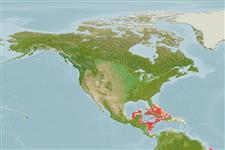>
Gobiiformes (Gobies) >
Gobiidae (Gobies) > Gobiinae
Etymology: Paedovaricus: Name from the root word ‘paed-’ (English spelling of the Greek root ‘ped-’, meaning ‘child’), combined with Varicus, referring to the small size of the type species and its general similarity to the genus Varicus..
More on author: Greenfield.
Environment: milieu / climate zone / depth range / distribution range
Ecologia
marinhas demersal; intervalo de profundidade 15 - 91 m (Ref. 92840). Tropical
Western Atlantic: Eleuthera Islands, Bahamas; Carrie Bow Cay, Belize.
Tamanho / Peso / Idade
Maturity: Lm ? range ? - ? cm
Max length : 1.4 cm SL macho/indeterminado; (Ref. 92840)
Descrição suscinta
Morfologia | Morfometria
Espinhos dorsais (total): 8; Raios dorsais (total): 7; Espinhos anais 1; Raios anais : 7; Vértebras: 27. Distinguished by the following characters: possesses all taxonomic characters present in most members of Gobiosomatini and Gobiosoma group (D1 VII, pterygiophore insertion pattern of 3-221110, vertebrae 27 with precaudal 11 and caudal 16, hypurals 1 and are 2 fused to some extent with hypurals 3 and 4 and the terminal vertebral element, 1 epural); pelvic fins are well separated, without both anterior frenum and well-developed membrane connecting innermost rays; pelvic-fin rays 1-5 unbranched, no flattened or fleshy tips; pelvic-fin rays very long, fourth ray extend posteriorly to origin of last anal-fin ray or beyond; scales on body (modified basicaudal scales present); an anal-fin pterygiophore inserted before first haemal spine, no cephalic lateralis canals and pores; D2 I,7; A I,7;body, head, and fins have a light yellowish orange hue, with diffuse dark vertical bars alongside of body, and very dark wide vertical band over posterior end of caudal peduncle and on the base of the caudal rays (Ref. 113825).
Rare in collections that little is known about the distribution and ecology (Ref. 92840).
Ciclo de vida ou comportamento de acasalamento
Maturidade | Reprodução | Desova | Ovos | Fecundidade | Larvas
Smith, C.L., 1997. National Audubon Society field guide to tropical marine fishes of the Caribbean, the Gulf of Mexico, Florida, the Bahamas, and Bermuda. Alfred A. Knopf, Inc., New York. 720 p. (Ref. 26938)
Status na Lista Vermelha da UICN (Ref. 130435)
Ameaça para os humanos
Harmless
Uso pelos humanos
Mais informação
Nomes comunsSinônimosMetabolismoPredadoresEcotoxicologiaReproduçãoMaturidadeDesovaAgregação de desovaFecundidadeOvosDesenvolvimento dos ovos
Idade/TamanhoCrescimentoPeso-comprimentoComprimento-comprimentoFrequências de comprimentoMorfometriaMorfologiaLarvasDinâmica larvalRecrutamentoAbundânciaBRUVS
ReferênciasAquaculturaPerfil para aquaculturaEstirpesGenéticaElectrophoresesHereditariedadeDoençasProcessamentoNutrientsConversão de massa
ColaboradoresFotosStamps, Coins Misc.SonsCiguateraVelocidadeTipo de nataçãoÁrea branquialOtólitosCérebrosVisão
Ferramentas
Relatórios especiais
Baixar XML
Fontes da internet
Estimates based on models
Preferred temperature (Ref.
123201): 23.6 - 27.6, mean 25.7 °C (based on 47 cells).
Índice de diversidade filogenética (Ref.
82804): PD
50 = 1.0000 [Uniqueness, from 0.5 = low to 2.0 = high].
Bayesian length-weight: a=0.00708 (0.00333 - 0.01504), b=3.09 (2.92 - 3.26), in cm total length, based on LWR estimates for this (Sub)family-body shape (Ref.
93245).
Nível Trófico (Ref.
69278): 3.0 ±0.3 se; based on size and trophs of closest relatives
Resiliência (Ref.
120179): Elevada, tempo mínimo de duplicação da população menor que 15 meses (Preliminary K or Fecundity.).
Fishing Vulnerability (Ref.
59153): Low vulnerability (10 of 100).
